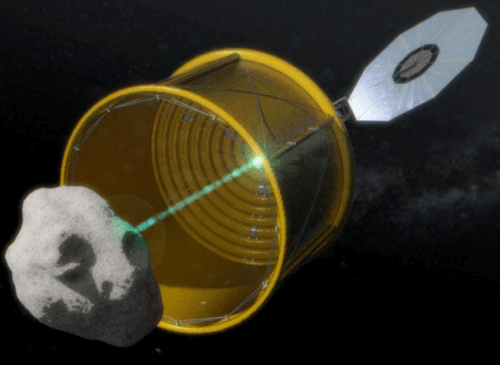For the purpose of the operation, NASA will develop the ability to propel spacecraft using a solar sail, and a system for detecting asteroids that endanger the Earth

Udi Lam also participated in the preparation of the article.
By the end of this decade, NASA plans to send a robotic spacecraft that will capture an asteroid up to 12 m in diameter and bring it into orbit around the moon. The operation is currently called the Asteroid Redirect Mission.
Six studies published as part of the Astronautics Conference currently taking place in Toronto, reveal the various possibilities for carrying out such a mission - whether using robotic, manned spacecraft or a combination of both types, and also try to assess what the implications of such a capability will be, among other things, in creating a new space economy.
The goals of the ARM mission, beyond proving the ability to utilize the minerals present in asteroids, are to serve as a catalyst for the development of technologies such as:
- Propulsion of spacecraft using a solar sail that converts solar energy into electrical energy, and accelerates charged particles with it
- Development of asteroid detection and tracking systems, as part of the plan to establish a warning and protection system for the Earth against the impact of objects from space
- Development of methods to divert asteroids from their orbits, as part of the same program.
- Advanced propulsion technologies that are supposed to be used in part for the planned trips to Mars.
In the article: NASA's space exploration planning: the asteroid mission and the step-wise path to mars, Kathleen Lorini from NASA's Johnson Space Center in Houston and Michelle Gates from NASA's headquarters in Washington write that as part of American policy, NASA continues to develop its space programs and plans to remain a world leader and an important partner in every space operation.
"The asteroid diversion mission is part of NASA's long-term plan so that it continues to make good use of taxpayer money," the two write. "NASA's plans reflect the importance of manned flights for the United States through a focus on basic capabilities and technologies that will ensure that government investment will continue to drive innovation and enable the execution of missions as part of planning to send humans to Mars."

NASA is preparing the infrastructure for the partnerships needed to launch humans beyond low Earth orbit. In addition to the space station, which enables the study of issues related to tasks that require a long stay in space, especially in relation to human health and performance."
"The Heavy Launch System (SLS) and the manned spacecraft of the Orion model are currently under development. Already the first models of the heavy launcher and the Orion spacecraft will be able to enable flights to the vicinity of the moon, and a demonstration of capabilities and operations required for manned missions leaving the relatively safe space of low orbit. These missions will enable the study of a near-Earth asteroid and the moon, with the team's presence encouraging the public in ways that will improve our lives on Earth." They conclude.
Raymond Merrill of NASA, John Brophy of JPL and MIT, and Peter Mueller of NASA presented research that describes the way to exploit the resources found on asteroids. This is an idea from before the space age. Today, the technologies are available that will make it possible to turn this initiative from an idea into a reality.
"The asteroid diversion mission is a test mission whose goal is to bring a small asteroid into orbit around the Earth - after all, it is a rock weighing several tons - into a circular orbit around the moon in the mid-2020s."
"The operation will use a Solar Electric Propulsion (SEP) vehicle and the technologies that exist today. The two offer an approach they call in-situ resource utilization (ISRU). "The change in perception that will be made possible thanks to the ARM mission will allow research into the ability to utilize the resources of asteroids and other bodies in the solar system, when an asteroid orbiting the moon will serve as a starting point for missions in deep space."
"If the ISRO program is implemented it will serve as the infrastructure for an entirely new space economy, they write."
Sources:
- The Asteroid Redirect Mission and Sustainable Human Exploration (7 MB PDF)
- Synergies of Robotic Asteroid Redirection Technologies and Human Space Exploration (669 KB PDF)
- An Overview of NASA's Asteroid Exploration Efforts: Past and Present (399 KB PDF)
- Technology Development for NASA's Asteroid Redirect Mission (5.5 MB PDF)
- Asteroid Redirect Mission Concept: A Bold Approach For Utilizing Space Resources (478 KB PDF)
- NASA's Space Exploration Planning: The Asteroid Mission and the Step-Wise Path to Mars (452 KB PDF)

2 תגובות
In my opinion, a way should be found to drop the asteroid on Earth and not deflect it
It is very important to develop a capability to deflect asteroids that could threaten Earth.
The question is whether in this specific mission there is no risk in bringing an asteroid close to the Earth.
Could a small asteroid do a lot of damage if it accidentally falls on Earth?